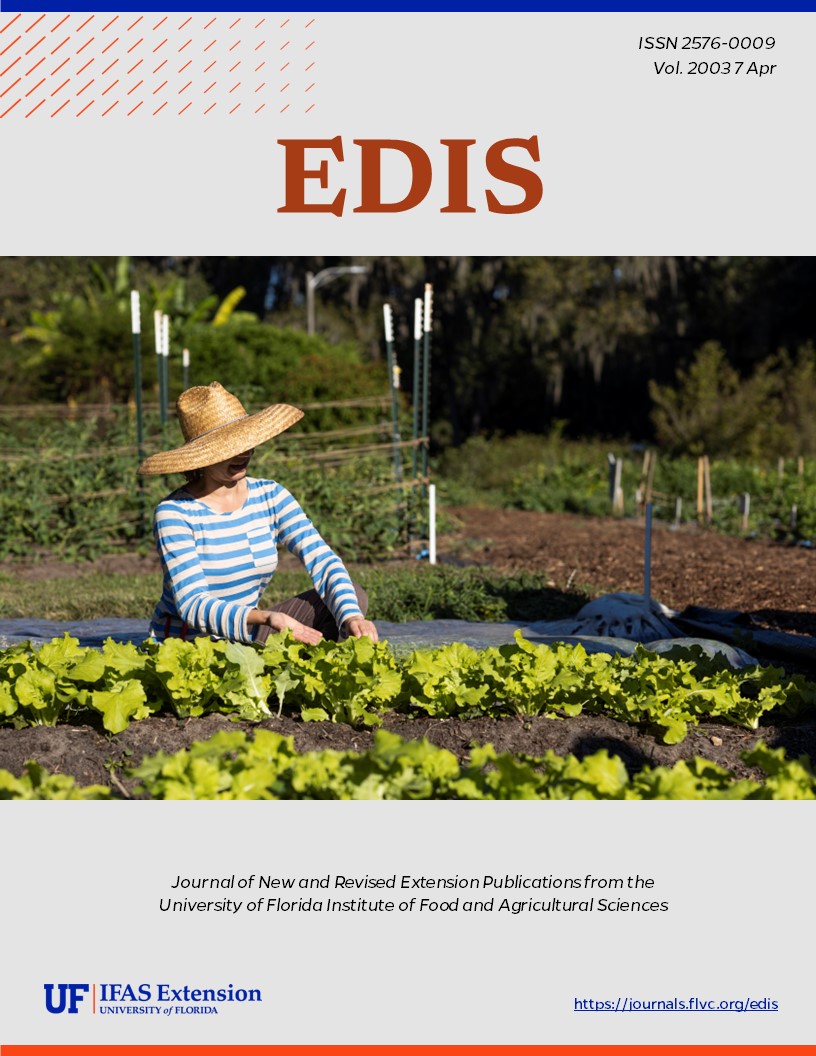Abstract
Crotons have been popular in tropical gardens for centuries. Crotons grow into shrubs and small trees in their native habitats of India, Malaysia, and some of the South Pacific islands. Few other plants can surpass them in both foliage color and leaf shape variation. Since some cultivars are tolerant of interior environments, crotons have also become very popular as interior potted foliage plants. One additional point, often overlooked, is that foliage of crotons is excellent material for use in floral arrangements. Both individual leaves and entire branches can be used in floral designs. This document is Circular ENH878, one of a series of the Environmental Horticulture Department, Florida Cooperative Extension Service, Institute of Food and Agricultural Sciences, University of Florida. Original publication date March 2003.
References
Benz, M.B. and J.L. Johnson. 1986. Flowers: Geometric Form. San Jacinto Publishing Co.
Conover, C.A. and R.T. Poole. 1983. Influence of shade and fertilizer levels on yield of croton stock plants. Proc. Fla. State Hort. Soc. 96:261-263.
Conover, C.A. and R.T. Poole. 1990. Light and fertilizer recommendations for production of acclimatized potted foliage plants. Univ. of Fla. IFAS, Central Fla. Res. and Ed. Cntr. - Apopka, CFREC-Apopka Res. Rpt. RH-90-1.
Dehgan, B. 1998. Landscape Plants for Subtropical Climates. Univ. Presses of Florida, Gainesville, FL.
Gilman, E.F. 1996. Florida Plant Guide. Betrock Information Systems, Hollywood, FL.
Hardenburg, R.E., A.E. Watada, and C.Y. Wang. 1986. The Commercial Storage of Fruits, Vegetables, and Florist and Nursery Stocks. U.S.D.A., Agr. Res. Serv., Agr. Handbook No. 66.
Henny, R.J., L.S. Osborne and A.R. Chase. 1991. Croton. Univ. of Fla. IFAS, Central Fla. Res. and Ed. Cntr.-Apopka Foliage Plant Res. Note RH-91-12.
Hunter, N.T. 1994. The Art of Floral Design. Delmar Publishers, Albany, NY.
McConnell, D.B., R.W. Henley, and R.L. Biamonte. 1981. Commercial foliage plants, pp. 544-593. In: J.N. Joiner (ed.). Foliage Plant Production. Prentice-Hall, Englewood Cliffs, NJ.
Poole, R.T. and C.A. Conover. 1987. Heat stress of foliage plants. Univ. of Fla.. IFAS, Central Fla. Res. and Ed. Cntr.-Apopka, CFREC-Apopka Res. Rpt. RH-87-2.
Poole, R.T. and C.A. Conover. 1990. Effects of light intensity and fertilizer formulation on six foliage plants growing indoors. Univ. of Fla.. IFAS, Central Fla. Res. and Ed. Cntr.-Apopka, CFREC-Apopka Res. Rpt. RH-90-16.
Reeves, R.G. and A. Bell. 1988. Codiaeum variegation pictum - A foliage favorite with new possibilities. Fla. Nurseryman 35(1):69, 71, 75, 78.
Short, D.E., L.S. Osborne, and R.W. Henley. 1984. Phytotoxicity of insecticides and miticides to foliage and woody ornamental plants. Univ. of Fla., IFAS., Exten. Entomology Rpt. #57.
Stamps. R.H. 1985. Effects of production shade level, foliage maturity, antitranspirants, floral preservative and cultivar on vase life of woody cut foliage crops. Proc. Fla. State Hort. Soc. 98:99-100.
Stamps. R.H. 1987. Major Florida cut foliage crops classified according to floral design and landscape usage. Proc. Fla. State Hort. Soc. 100:179-180.
Unless otherwise specified, articles published in the EDIS journal after January 1, 2024 are licensed under a Creative Commons Attribution-NonCommercial-NoDerivs 4.0 International (CC BY-NC-ND 4.0) license.

